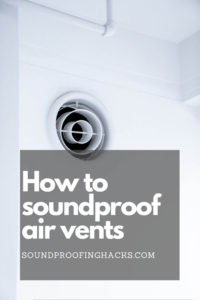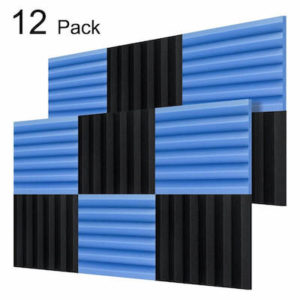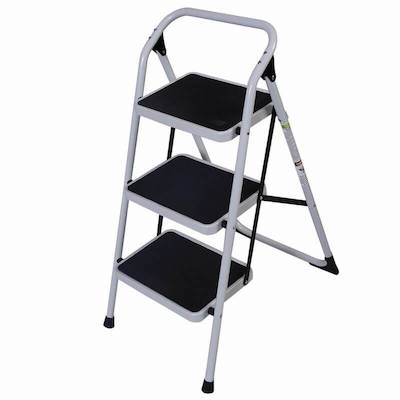How to soundproof air vents: 3 Easy methods that work
I have a nice office at home. It’s the right size and has all the materials I need to work without a long commute. However, if my spouse was cooking, I could hear the loud appliances through the air vent, which led me to thinking how to soundproof air vents.

If my son was playing the drums or doing woodworking in the garage—same problem. I am not very handy and do not enjoy working on the house. I had no desire to wear headphones or anything else.
For a short time, I considered returning to the office in order to have quiet while working and on conference calls.
But then I learned you can actually soundproof an air vent itself. I was not sure if I wanted to block off the vent—and risk losing the heating and cooling—or if there were other options.
It turns out there are several strategies you can use to quiet your air vent.
Related: How to soundproof a garage door from the inside? 3 easy ways to get started
I am an Amazon Affiliate, which means I may make a commission if you purchase something through the links here. There is NO extra cost to you at all, and THANK YOU so much for the support.
Contents: Skip to section
Types of noise
There are two types of sounds that pass through your house.
Airborne is the type of noise that passes through the air: music, television, conversation, anything of that sort.
If you are getting sounds through your air vent of this type, then you have quite a few options.
Structural or impact noise is the type of noise that results from people walking around or bumping into things. This travels through the frame of the house and that’s a topic you can find in other articles in this blog.
Just keep this in mind when you decide if working on your air vent is a good option for you.
Who is this for and why is this article helpful?
If you have a home or apartment and are getting noise through your air vent that you want to cut down on, then this article is for you.
If you are willing to purchase a few simple items and employ a few simple strategies, you can make a big difference.

At first, I was worried I would need to block the air vent. I had visions of closing it off completing and being stuck in a room that was always too hot or too cold.
Then the more research I did, the more I realized I could, indeed, keep the air flowing while cutting back on the noise.
The noise coming through the air vent might be enough to disturb your sleep or work.
But a little bit of effort can fix the noise interfering with your sleep and work.
What are my options? Recommended Gear
Aside from permanently sealing up the air vent permanently what are the options?
- A sound maze, which will absorb sound and bounce waves away from your direction
- Insulating Sealant
- Acoustic foam in or over the vent
- Soundproof blankets
Sound maze
Probably the best way to soundproof an air vent by creating what is typically called a sound maze inside your air vent and duct.
It will definitely cut down on the noise coming through your vent, but will not block airflow, a critical balance to strike in this type of project.
To do this you will make mini-sound barriers that will go in the duct, which will absorb sound, but leave a gap for the air to flow through.
The materials recommended below will help bounce sound back from passing into your room from another source and will deaden the sound before it gets to you.
When you add these items, the air itself will flow in a zig-zag motion through the maze, but the sound will eventually dissipate before reaching you.
Tools you need:
- Plywood
- Acoustic foam
- A Step Ladder
- Green Glue or Gorilla Wood Glue
- Screwdriver
- Utility Knife
- Wood Saw
Acoustic Foam
Made of high quality environmentally polyurethane foam, these studio foam are durable and effective, no health risks, safe to use.
These are highly rated and I have used them multiple times and found them to be a good balance of effectiveness and budget.
Baltic Birch Plywood
This comes in individual sheets, so depending on how many vents or other projects you plan for it, just order the exact quantity. It’s a standard size of ¼” X 12” X 12”, ensuring there is enough material to work with on each panel and that this is thin enough for this project.
Klein Tools Screwdriver
This tool doubles as a screwdriver and nut driver.
It includes eight common screwdriver tips as well as three different nut driver tips, making it versatile and easy to use for nearly any project.
Irwin Screwdriver
This is another multi-tool driver, with nine screwdriver bits and nut drivers. The Klein is a standard workhorse tool, whereas this Irwin focuses a little more on design.
The bits are stored in the handle for extreme convenience anytime you need to change them.
The handle is ergonomic and designed specifically for slip resistance, making for comfortable safe usage.
Worx Cordless Circular Saw
This power saw is small and easy to use for anyone who doesn’t want to have to cut manually.
It weighs less than most power saws, but is still powerful enough to cut wood, metal, tile, or plastic.
The grip is designed for comfort and safety, including a safety trigger.
Irvin Hand Saw
If you do not want or need an electrical circular saw, this hand saw is likely a better fit.
This saw is the standard handle and blade design.
The handle is designed for comfort and control and the teeth have been treated to retain their sharpness for a long time.
Zimtown Portable Folding 3 Step Ladder
This model is designed to be extra sturdy and has anti-slip rubber on grip and steps.
If you need to be a little higher than most step ladders, this is a good option with it’s 3 steps.
This arrives fully assembled and folds up easily for storage.
Gorilla Glue
The Gorilla Glue is well-known for its strength and versatility for this project or nearly any surface for which you need a powerful permanent glue.
This glue is clear (which is nice if it will be visible in your project at all) and is water resistant.
Green Glue
Green Glue is the industry standard for any project that requires a sound-proof adhesive.
While it is called green glue, this product is actually white. It is sold in a caulking tube and therefore requires a caulk gun.
Utility Knife
This is one of the Best Sellers in this category for a reason: it’s simple and safe. The rubber grip, sliding and adjustable blade, and lock-into-place features make this an easy knife to use.
Komelon Self Lock Measuring Tape
This tape is 25ft in length and includes a locking button to make measuring easier, particularly if you’re the only one working on the project. The entire outer shell is rubberized for durability and impact resistance.
Steps to build your sound maze
- Shut off your HVAC system (or wait until you’re ready to install the maze).
- Using the stepladder and screwdriver, remove the air vent cover.
- Measure how far back into the vent you are comfortable placing the maze walls. Remember you will need to hold it in place for a few minutes while the glue dries.
- Measure the height and width of the vent.
- You will want to keep the maze walls 1-2 inches apart from each other. Determine how many of the walls you will need, keeping in mind you will place them in a zig-zag fashion, alternating between the left and right side of the duct maze. They should be as tall as your airduct and roughly two-thirds the width.
- Using your tools, cut the plywood into pieces.
- Now cut the foam panels into matching pieces and glue them to the plywood.
- When the glue is dry you can begin installation.
- Place the pieces as far back as you feel comfortable, adding glue to them on three sides and holding them in place until they dry and can stand on their own. Continue in an alternating pattern.
- Wait the designed time on the glue container to ensure the glue is fully dry—you do not want to breath in glue fumes. Once it is dry, turn the HVAC back on and ensure the glue and placement has worked.
- Replace the vent.
Sealing Off a Vent
If the above is too much to try right now, there are other, easier methods.
Try using a Soundproofing Sealant.
If the HVAC vent is not active, or you do not need the airflow from it, you can seal it off. There are several options for this but the easiest one to use is the insulating foam sealant. Foam sealant will expand to fill the air vent.
Dow Great Stuff Pro Insulating Foam
Great Stuff, a polyurethane-based foam, will expand as you spray it in your air vent. The end result is a strong, water-resistant and airtight blockage inside your air vent, which is sure to cut down sound.
Using Insulating Foam
- Turn off your HVAC system.
- Remove the air vent cover.
- Reach in and spray the foam sealant into the duct. Keep in mind it will expand, so unless you want it to be visible, reach back into the vent and apply the sealant.
- Once you have filled a section, and the sealant has set, it will be airtight and relatively soundproof.
- Be sure the sealant is fully dry, then you can replace the vent.
- Turn on HVAC system to test.
Cover the Air Vent
You can temporarily cover the vent itself with one of several items.
Soundproof blanket
You can install any number of soundproof blankets with nails, hooks, or other hanging tools. You have two options with this: you can cut the blanket to fit over the vent or you cant stuff the blanket inside the vent. If you go with the later, just ensure you bunch it up enough to fill up the space tightly. It will not be as effective as other methods, but it will make a difference.
Moving Blankets
While not as aesthetically pleasing as regular blankets, these heavy blankets are heavy and effective.
Cut to fit or hang as is, these are thick and padded for moving, but are thick enough to provide sound dampening.
Acoustic Foam
Even if you do not want to make a full-blown sound maze, you can put your acoustic foam panels to good use. Cut them to the size of your air vents and glue them to the back (inside) of the air vents.
This will not cut down on sound as much as the maze, but will dampen the noise. (See acoustic foam panels above in the maze instructions for product selection.)
Acoustic Panel
If you do not want a blanket or acoustic panel hanging over your vent, you can also consider a decorative acoustic wall panel, which has the added benefit of being aesthetically pleasing.
Acoustic Panel
Art3d Decorative 3D Wall Panels
These are paintable and textured 3D wall panels you can hang over air vents, for a stylish sound covering.
Frequently Asked Questions (FAQ)
Is it OK to cover my air vents?
Industry experts indicate that covering your air vents may impact your HVAC efficiency. The primary safety concern is whether your home may have asbestos or not. If it is relatively old, it could.
Blocking the vent can potentially cause air flow buildup which may dislodge particles. Aside from that, the main concern is a potential drop in efficiency.
For these reasons, this article provides solutions other than simply covering or blocking your vent. If you’re concerned about any of this, consult an HVAC technician first.
To soundproof my air vents do I need to cover them and block air flow?
No, there are several options available to you. The best option is a sound maze, which does not cover or block the air flow at all. It absorbs and deflects the sound, but does not impeded air flow.
Do I need an HVAC technician to soundproof my air vents?
No. While it may be a good idea to consult one initially about any concerns related to your HVAC system, all soundproofing of air vents can be accomplished with a few simple tools and materials.
Even the most complex solution discussed here only requires a few materials and a saw and glue.
How to soundproof air vents: Conclusion
There are a number of strategies to choose from here.
The best in terms of soundproofing and airflow is clearly the sound maze.
It is not too hard to create and but it makes a significant difference.
Be sure to click through to find out more about the products and choose the one that suits your needs the most.
Good luck with your soundproofing project!
Additional Resources:
- How to make a soundproof box? 10 Simple steps that work
- 8 Best Earplugs for Shooting (updated 2020)
- 9 Best Acoustic Partitions: How to choose the right one
- How to make air conditioner quieter? 6 simple tips that work!
- How much does it cost to soundproof a room: Smart ways to save money
- Why Does My Laptop Sound Like a Jet Engine? Easy Fixes














